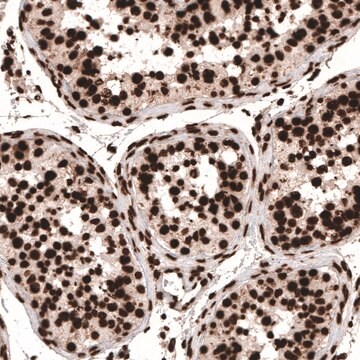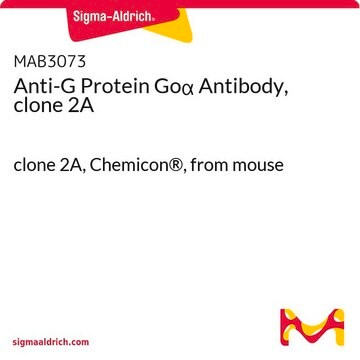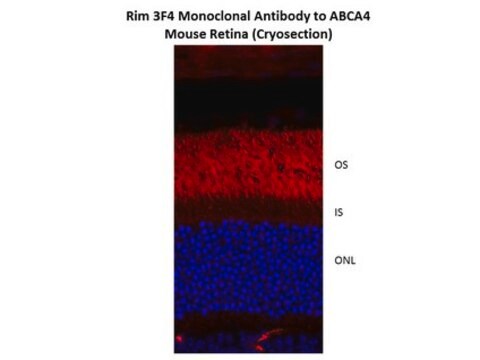MAB3077
Anti-G Protein Giα-2 Antibody, clone L5
clone L5, Chemicon®, from mouse
Sign Into View Organizational & Contract Pricing
All Photos(1)
About This Item
UNSPSC Code:
12352203
eCl@ss:
32160702
NACRES:
NA.41
Recommended Products
biological source
mouse
Quality Level
antibody form
purified immunoglobulin
antibody product type
primary antibodies
clone
L5, monoclonal
species reactivity
bovine, mouse, human, rat, guinea pig
manufacturer/tradename
Chemicon®
technique(s)
western blot: suitable
isotype
IgG2b
NCBI accession no.
UniProt accession no.
shipped in
wet ice
target post-translational modification
unmodified
Gene Information
human ... GNAI2(2771)
Specificity
Gialpha-2. Strong reactivity with bovine (100%), mouse (69%), rat (69%), human (62%) and guinea pig (43%). Specificity confirmed by Western blot versus bovine Galphat, rat Goalpha, rat Gialpha-1, Gialpha-2, rat Gialpha-3, bovine Gsalpha, and murine GoalphaA and GoalphaB.
Immunogen
Recombinant Gialpha-2, purified by the method of Linder (1990).
Application
Anti-G Protein Giα-2 Antibody, clone L5 is an antibody against G Protein Giα-2 for use in WB.
Research Category
Signaling
Signaling
Research Sub Category
GPCR, cAMP/cGMP & Calcium Signaling
GPCR, cAMP/cGMP & Calcium Signaling
Western blot 1:500 - 1:1000, with detection by 125I-labeled anti-IgG.
Labels a single protein band of 39 - 42 kDa in bovine and rat membranes.
Optimal working dilutions must be determined by end user.
Labels a single protein band of 39 - 42 kDa in bovine and rat membranes.
Optimal working dilutions must be determined by end user.
Physical form
Format: Purified
Purified immunoglobulin, in 0.02M phosphate buffer, 0.25M sodium chloride, pH 7.6, with 0.1% sodium azide.
Storage and Stability
Maintain at 2-8°C.
Other Notes
Concentration: Please refer to the Certificate of Analysis for the lot-specific concentration.
Legal Information
CHEMICON is a registered trademark of Merck KGaA, Darmstadt, Germany
Disclaimer
Unless otherwise stated in our catalog or other company documentation accompanying the product(s), our products are intended for research use only and are not to be used for any other purpose, which includes but is not limited to, unauthorized commercial uses, in vitro diagnostic uses, ex vivo or in vivo therapeutic uses or any type of consumption or application to humans or animals.
Not finding the right product?
Try our Product Selector Tool.
Storage Class Code
10 - Combustible liquids
WGK
WGK 2
Flash Point(F)
Not applicable
Flash Point(C)
Not applicable
Certificates of Analysis (COA)
Search for Certificates of Analysis (COA) by entering the products Lot/Batch Number. Lot and Batch Numbers can be found on a product’s label following the words ‘Lot’ or ‘Batch’.
Already Own This Product?
Find documentation for the products that you have recently purchased in the Document Library.
Lucien Gazi et al.
British journal of pharmacology, 138(5), 775-786 (2003-03-19)
(1) The human dopamine D(2long) (D(2L)) receptor was expressed with four different G proteins in Sf9 cells using the baculovirus expression system. When co-expressed with G(i)/G(o) G proteins (G(i1)alpha, G(i2)alpha, G(i3)alpha, or G(o)alpha, plus Gbeta(1) and Ggamma(2)), the receptor displayed
A family of nonclassical class I MHC genes contributes to ultrasensitive chemodetection by mouse vomeronasal sensory neurons.
Leinders-Zufall, T; Ishii, T; Chamero, P; Hendrix, P; Oboti, L; Schmid, A; Kircher et al.
The Journal of Neuroscience null
Ryoko Koizumi et al.
The Journal of veterinary medical science, 80(7), 1054-1060 (2018-05-16)
Wild animals typically exhibit defensive behaviors in response to a wider range and/or a weaker intensity of stimuli compared with domestic animals. However, little is known about the neural mechanisms underlying "wariness" in wild animals. Wild rats are one of
Jennifer M Lin et al.
eLife, 11 (2022-09-17)
Neuronal identity dictates the position in an epithelium, and the ability to detect, process, and transmit specific signals to specified targets. Transcription factors (TFs) determine cellular identity via direct modulation of genetic transcription and recruiting chromatin modifiers. However, our understanding
Kati S Mönkkönen et al.
Human reproduction (Oxford, England), 22(5), 1224-1230 (2007-03-10)
Heterotrimeric G proteins take part in membrane-mediated cell signalling and have a role in hormonal regulation. This study clarifies the expression and localization of the G protein subunit G alpha(i2) in the human endometrium and Fallopian tube and changes in
Our team of scientists has experience in all areas of research including Life Science, Material Science, Chemical Synthesis, Chromatography, Analytical and many others.
Contact Technical Service








